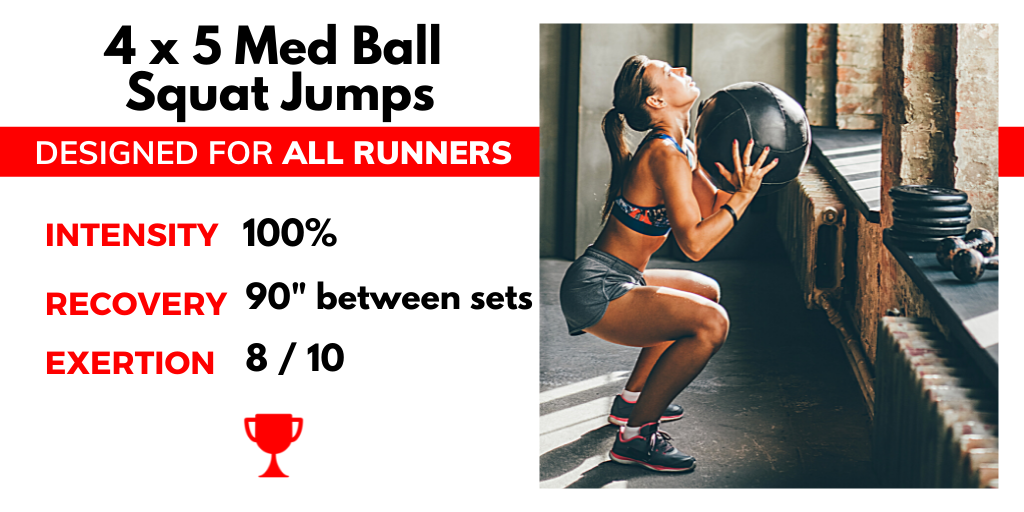4 x 5 Med Ball Squat Jumps
4 x 5 Med Ball Squat Jumps
Designed for ALL runners
Intensity
100% for every jump
Recovery
90” rest between sets
Exertion
8/10
Periodization
General Period
Context & Details
My favorite strength training implements are kettlebells, medicine balls, Indian clubs, and boxes. A hex bar and barbell are useful as well.
One of the biggest myths among runners is they shouldn't — or don’t need to — strength train.
The science is clear: Runners who do run faster, runners who don’t run slower.
Strength training improves neurological functioning, connective tissue resiliency, muscle coordination — both intra- (within a muscle) and inter-coordination (between muscles) — as well as power and antifragility to injury.
More and more coaches and runners are wising up to the importance of strength training. However, confusion still exists regarding the most effective methods.
It’s best to keep things simple and prioritize exercises that require little, or basic, equipment and are in the zip code of the running movement pattern.
One such exercise is the Squat Jump.
Squat Jumps can teach runners many things, but I will focus on two:
Repositioning the hips rapidly from a position of deep flexion towards extension
Absorption and transference of potential and stored kinetic energy into expressed kinetic energy
If you want better results by learning more about squat training for runners, Join the Running Scholar Program for only $29 and get unlimited access to courses and real-world strength training workouts used by high-performance coaches runners.
Mechanically speaking, running speed is governed by the range of motion of the hips. The greater the range of motion and the more rapid the hips move from flexion into extension and back each stride the faster humans run.
This is why quality hip mobility and a high degree of hip strength are so important for runners.
Here’s a useful visual showing some of the different postions of the hips I just touched on:
In addition to teaching runners how to dynamically reposition their hips, squat jumps allow runners to practice recycling kinetic energy in a continuous manner.
The short stretch response is a power mechanism runners can use to make running more efficient by becoming less dependant on caloric tissue. The less caloric tissue used to create locomotion the less oxygen is used resulting in better running economy and sustaining faster speeds for longer before fatigue forces a slowdown.
Getting good at recycling kinetic energy is vital to running performance and this is where squat jumps, performed with the correct intent, can help.
Here’s a good video of a squat jump (without a medicine ball) performed with the intent of harnessing and recycling kinetic energy:
Once a runner has mastered the squat jump with only bodyweight, you can add a medicine ball to increase the demand. Somewhere in the 2lbs to 10lbs range is adequate. Preferable a large soft medicine ball.
Be sure they keep the medicine ball in contact with the sternum throughout each jump, braking contact from the chest can throw them off balance and make the activity harder as well as increase the risk of strain.
Ideally, squat jumps are performed 3 - 4 times per week after little or non-taxing running sessions throughout the General and Foundation periods of training.
Expected results include better speed, strength, power, range of motion, and explosiveness in the hips which will improve running posture, everyday running pace, and finishing kick potency.
Any questions? Direct Message me on twitter.
Thx. | jm
Get Better Results with The Running Scholar Program.
Join the Scholar Program for $29 to learn more about successful squats for runners and get unlimited access to courses and training programs which include strength training programming for runners
3 Good Books on the benefits of Kettlebell Swings
Kettlebell Simple & Sinister by Pavel Tsatsouline
Enter The Kettlebell!: Strength Secret of the Soviet Supermen by Pavel Tsatsouline
Athletic Development by Vern Gambetta



